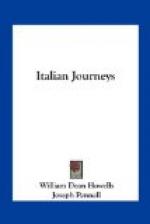He was a very well-mannered person, but had, of course, the bashfulness naturally resulting from lonely life at that altitude, where contact with the world must be infrequent. His fellow-citizens seemed to regard him with a kind of affectionate deference, and some of them came in to hear him talk with the strangers. He stood till we prayed him to sit down, and he presently consented to take some wine with us.
After all, however, he could not tell us much of his people which we had not heard before. A tradition existed among them, he said, that their ancestors had fled to these Alps from Marius, and that they had dwelt for a long time in the hollows and caves of the mountains, living and burying their dead in the same secret places. At what time they had been converted to Christianity he could not tell; they had, up to the beginning of the present century, had little or no intercourse with the Italian population by which they were surrounded on all sides. Formerly, they did not intermarry with that race, and it was seldom that any Cimbrian knew its language. But now intermarriage is very frequent; both Italian and Cimbrian are spoken in nearly all the families, and the Cimbrian is gradually falling into disuse. They still, however, have books of religious instruction in their ancient dialect, and until very lately the services of their church were performed in Cimbrian.
I begged the Capo to show us some of their books and he brought us two,—one a catechism for children, entitled “Dar Kloane Catechism vor z’ Beloseland vortraghet in z’ gaprecht von siben Komuenen, un vier Halghe Gasang. 1842. Padova.” The other book it grieved me to see, for it proved that I was not the only one tempted in recent times to visit these ancient people, ambitious to bear to them the relation of discoverer, as it were. A High-Dutch Columbus, from Vienna, had been before me, and I could only come in for Amerigo Vespucci’s tempered glory. This German savant had dwelt a week in these lonely places, patiently compiling a dictionary of their tongue, which, when it was printed, he had sent to the Capo. I am magnanimous enough to give the name of his book, that the curious may buy it if they like. It is called “Johann Andreas Schweller’s Cimbrisches Woerterbuch. Joseph Bergman. Vienna, 1855.”
Concerning the present Cimbri, the Capo said that in his community they were chiefly hunters, wood-cutters, and charcoal-burners, and that they practiced their primitive crafts in those gloomier and wilder heights we saw to the northward, and descended to the towns of the plain to make sale of their fagots, charcoal, and wild-beast skins. In Asiago and the larger communities they were farmers and tradesmen like the Italians; and the Capo believed that the Cimbri, in all their villages, numbered near ten thousand. He could tell me of no particular customs or usages, and believed they did not differ from the Italians now except in race and language. [The English traveller




